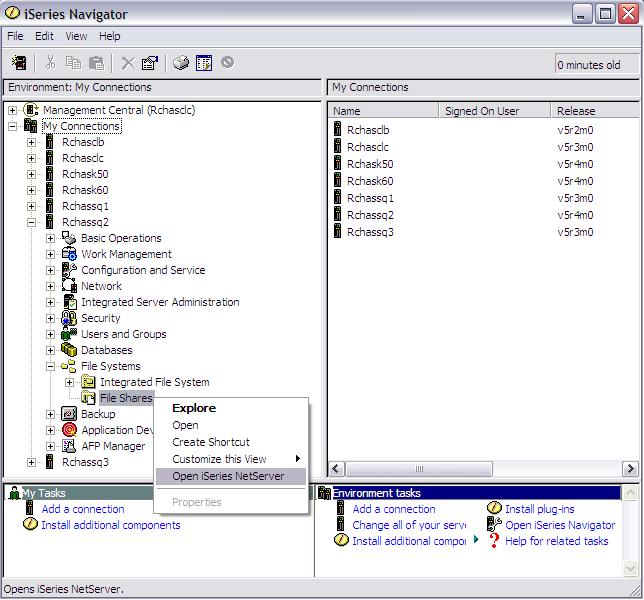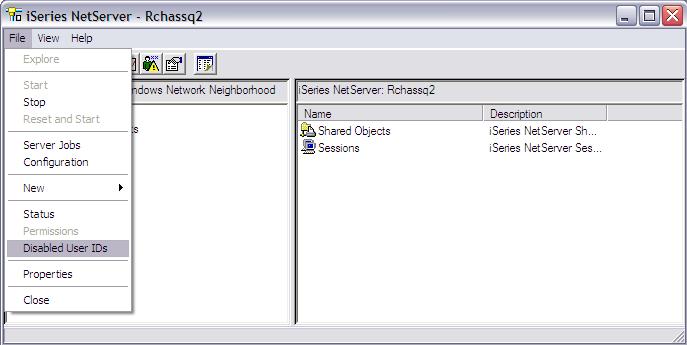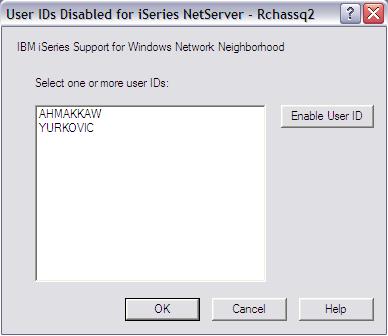IBM Says…
When an IBM System i user profile is disabled for NetServer access, message CPIB682 is posted to the QSYSOPR message queue. This disabled user profile is added to the NetServer Disabled User ID list the next time the user attempts to connect to a NetServer resource.
Messages that have been issued for all user IDs disabled for NetServer within the time span covered by the current QHST History File can be seen by running the following command:
[cc lang=”php”]DSPLOG MSGID(CPIB682)[/cc]
Running the WRKUSRPRF command (Option 5 to display) or the DSPUSRPRF command does not show if a user is disabled for NetServer access. These commands show only if a user profile is disabled for standard operating system access methods; for example, 5250 (Telnet), FTP, iSeries Access, and other similar functions.
The methods used to list disabled users for NetServer are System i Navigator and GO NETS. GO NETS is an operating system command line interface for working with NetServer attributes natively using NetServer APIs. Information on GO NETS can be found from a link on the NetServer home page. The following link will access information related to the GO NETS menu.



The Disabled User ID list that is viewed through GO NETS or System i Navigator might be misleading. When a user profile is disabled for NetServer access, message CPIB682 is posted to the QSYSOPR Message Queue; however, the user profile is not added to the Disabled User ID list until the next time the user attempts to access NetServer.
Once the profile is re-enabled using the [Enable User ID] button, the profile name disappears from the list immediately.
[cc lang=”php”]
**
** Program . . : CBX110
** Description : List and enable disabled NetServer users
** Author . . : Carsten Flensburg
**
**
** Compile options:
**
** CrtRpgMod Module( CBX110 ) DbgView( *LIST )
**
** CrtPgm Pgm( CBX110 )
** Module( CBX110 )
**
**
**– Header specifications: ——————————————–**
H Option( *SrcStmt )
**– API error data structure:
D ERRC0100 Ds Qualified
D BytPrv 10i 0 Inz( %Size( ERRC0100 ))
D BytAvl 10i 0
D MsgId 7a
D 1a
D MsgDta 256a
**– Global constants:
D OFS_MSGDTA c 16
**– Global variables:
D Idx s 10i 0
D MsgRpy s 32a Varying
D NetSvrUsr s 10a Varying
**– API parameters:
D ZLSL0900 Ds Qualified
D DsaNetUsr 10a Dim( 1024 )
**– List information:
D LstInf Ds Qualified
D RcdNbrTot 10i 0
D RcdNbrRtn 10i 0
D RcdLen 10i 0
D InfLenRtn 10i 0
D InfCmp 1a
D Dts 13a
D 34a
**– Request variable:
D ZLSS0200 Ds Qualified
D NbrSvrUsr 10i 0
D NetSvrUsr 10a Dim( 1024 )
**– Open list of server information:
D LstSvrInf Pr ExtPgm( ‘QZLSOLST’ )
D LsRcvVar 32767a Options( *VarSize )
D LsRcvVarLen 10i 0 Const
D LsLstInf 64a
D LsFmtNam 10a Const
D LsInfQual 15a Const
D LsError 32767a Options( *VarSize )
**
D SiSsnUsr 10a Const Options( *NoPass )
**
D SiSsnId 20i 0 Const Options( *NoPass )
**– Change server information:
D ChgSvrInf Pr ExtPgm( ‘QZLSCHSI’ )
D CsRqsVar 32767a Const Options( *VarSize )
D CsRqsVarLen 10i 0 Const
D CsFmtNam 10a Const
D CsError 32767a Options( *VarSize )
**– Send program message:
D SndPgmMsg Pr ExtPgm( ‘QMHSNDPM’ )
D SpMsgId 7a Const
D SpMsgFq 20a Const
D SpMsgDta 512a Const Options( *VarSize )
D SpMsgDtaLen 10i 0 Const
D SpMsgTyp 10a Const
D SpCalStkE 10a Const Options( *VarSize )
D SpCalStkCtr 10i 0 Const
D SpMsgKey 4a
D SpError 512a Options( *VarSize )
**
D SpCalStkElen 10i 0 Const Options( *NoPass )
D SpCalStkEq 20a Const Options( *NoPass )
D SpDspWait 10i 0 Const Options( *NoPass )
**
D SpCalStkEtyp 20a Const Options( *NoPass )
D SpCcsId 10i 0 Const Options( *NoPass )
**– Receive program message:
D RcvPgmMsg Pr ExtPgm( ‘QMHRCVPM’ )
D RpRcvVar 32767a Options( *VarSize )
D RpRcvVarLen 10i 0 Const
D RpFmtNam 10a Const
D RpCalStkE 256a Const Options( *VarSize )
D RpCalStkCtr 10i 0 Const
D RpMsgTyp 10a Const
D RpMsgKey 4a Const
D RpWait 10i 0 Const
D RpMsgAct 10a Const
D RpError 32767a Options( *VarSize )
**
D RpCalStkElen 10i 0 Const Options( *NoPass ) call stack counter
D RpCalStkEq 20a Const Options( *NoPass ) call stack counter
**
D RpCalStkEtyp 20a Const Options( *NoPass ) call stack counter
D RpCcsId 10i 0 Const Options( *NoPass ) call stack counter
**– Get inquiry message reply:
D GetInqRpy Pr 128a Varying
D PxMsgDta 512a Const Varying
**– Send completion message:
D SndCmpMsg Pr 10i 0
D PxMsgDta 512a Const Varying
**– Send escape message:
D SndEscMsg Pr 10i 0
D PxMsgId 7a Const
D PxMsgF 10a Const
D PxMsgDta 512a Const Varying
/Free
LstSvrInf( ZLSL0900
: %Size( ZLSL0900 )
: LstInf
: ‘ZLSL0900’
: *Blank
: ERRC0100
);
If ERRC0100.BytAvl > *Zero;
SndEscMsg( ERRC0100.MsgId
: ‘QCPFMSG’
: %Subst( ERRC0100.MsgDta: 1: ERRC0100.BytAvl – OFS_MSGDTA )
);
ElseIf LstInf.InfCmp = ‘C’;
For Idx = 1 to LstInf.RcdNbrTot;
ExSr PrcLstEnt;
EndFor;
EndIf;
SndCmpMsg( ‘NetServer user activation completed.’ );
Return;
BegSr PrcLstEnt;
NetSvrUsr = %TrimR( ZLSL0900.DsaNetUsr(Idx) );
MsgRpy = GetInqRpy( ‘NetServer user ‘ + NetSvrUsr +
‘ disabled. Enable NetServer user (Y=Yes)?’
);
If %Xlate( ‘y’:’Y’: MsgRpy ) = ‘Y’;
ZLSS0200.NbrSvrUsr = 1;
ZLSS0200.NetSvrUsr(1) = NetSvrUsr;
ChgSvrInf( ZLSS0200: %Size( ZLSS0200 ): ‘ZLSS0200’: ERRC0100 );
If ERRC0100.BytAvl > *Zero;
If ERRC0100.BytAvl < OFS_MSGDTA;
ERRC0100.BytAvl = OFS_MSGDTA;
EndIf;
SndEscMsg( ERRC0100.MsgId
: 'QCPFMSG'
: %Subst( ERRC0100.MsgDta
: 1
: ERRC0100.BytAvl - OFS_MSGDTA
)
);
Else;
SndCmpMsg( 'NetServer user ' + NetSvrUsr + ' enabled.' );
EndIf;
EndIf;
EndSr;
/End-Free
**-- Get inquiry message reply: ----------------------------------------**
P GetInqRpy B
D Pi 128a Varying
D PxMsgDta 512a Const Varying
**
D MsgKey s 4a
**-- Message information structure:
D RCVM0100 Ds Qualified
D BytPrv 10i 0
D BytAvl 10i 0
D MsgSev 10i 0
D MsgId 7a
D MsgTyp 2a
D MsgKey 4a
D 7a
D CcsIdCnvSts 10i 0
D CcsIdDta 10i 0
D MsgLenRtn 10i 0
D MsgLenAvl 10i 0
D MsgRpy 32a
/Free
SndPgmMsg( *Blanks
: *Blanks
: PxMsgDta
: %Len( PxMsgDta )
: '*INQ'
: '*EXT'
: *Zero
: MsgKey
: ERRC0100
);
RcvPgmMsg( RCVM0100
: %Size( RCVM0100 )
: 'RCVM0100'
: '*'
: *Zero
: '*RPY'
: MsgKey
: -1
: '*OLD'
: ERRC0100
);
Return %Subst( RCVM0100.MsgRpy: 1: RCVM0100.MsgLenRtn );
/End-Free
P GetInqRpy E
**-- Send completion message: ------------------------------------------**
P SndCmpMsg B
D Pi 10i 0
D PxMsgDta 512a Const Varying
**
D MsgKey s 4a
/Free
SndPgmMsg( 'CPF9897'
: 'QCPFMSG *LIBL'
: PxMsgDta
: %Len( PxMsgDta )
: '*COMP'
: '*PGMBDY'
: 1
: MsgKey
: ERRC0100
);
If ERRC0100.BytAvl > *Zero;
Return -1;
Else;
Return 0;
EndIf;
/End-Free
P SndCmpMsg E
**– Send escape message: ———————————————-**
P SndEscMsg B
D Pi 10i 0
D PxMsgId 7a Const
D PxMsgF 10a Const
D PxMsgDta 512a Const Varying
**
D MsgKey s 4a
/Free
SndPgmMsg( PxMsgId
: PxMsgF + ‘*LIBL’
: PxMsgDta
: %Len( PxMsgDta )
: ‘*ESCAPE’
: ‘*PGMBDY’
: 1
: MsgKey
: ERRC0100
);
If ERRC0100.BytAvl > *Zero;
Return -1;
Else;
Return 0;
EndIf;
/End-Free
P SndEscMsg E
[/cc]
[wordpress_file_upload multiple=”false” fitmode=”responsive” captcha=”true” captchatype=”RecaptchaV2 (no account)” postlink=”true”]